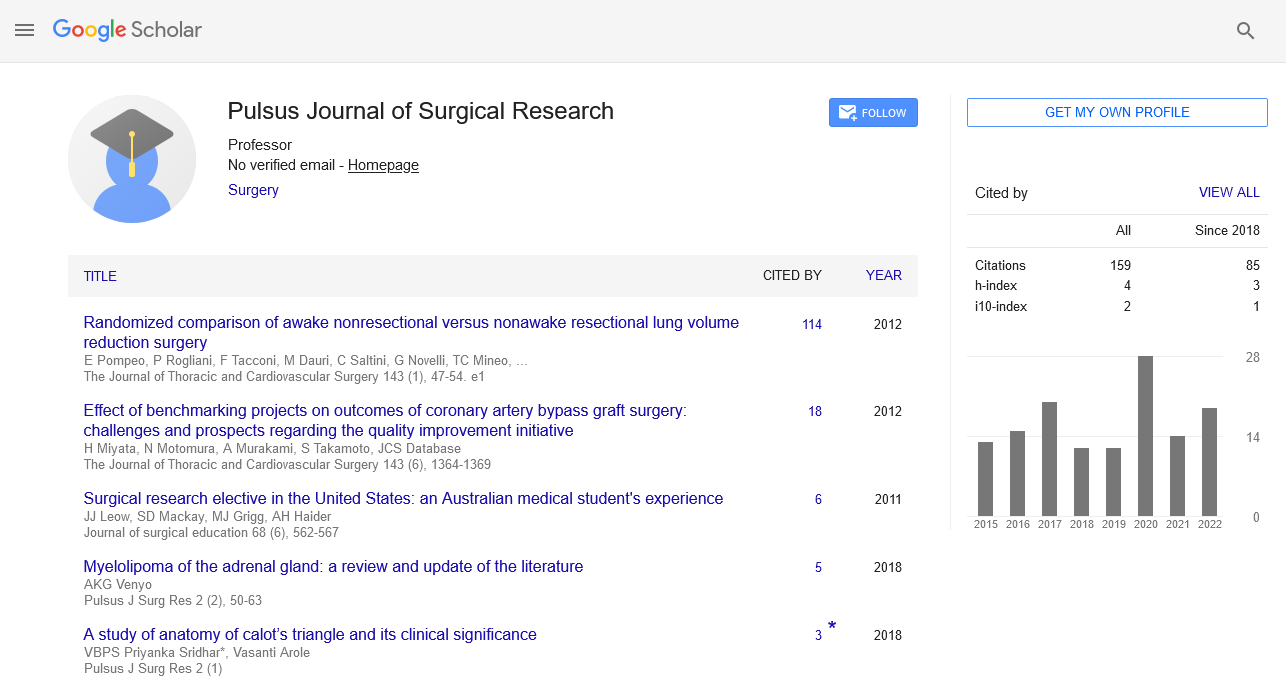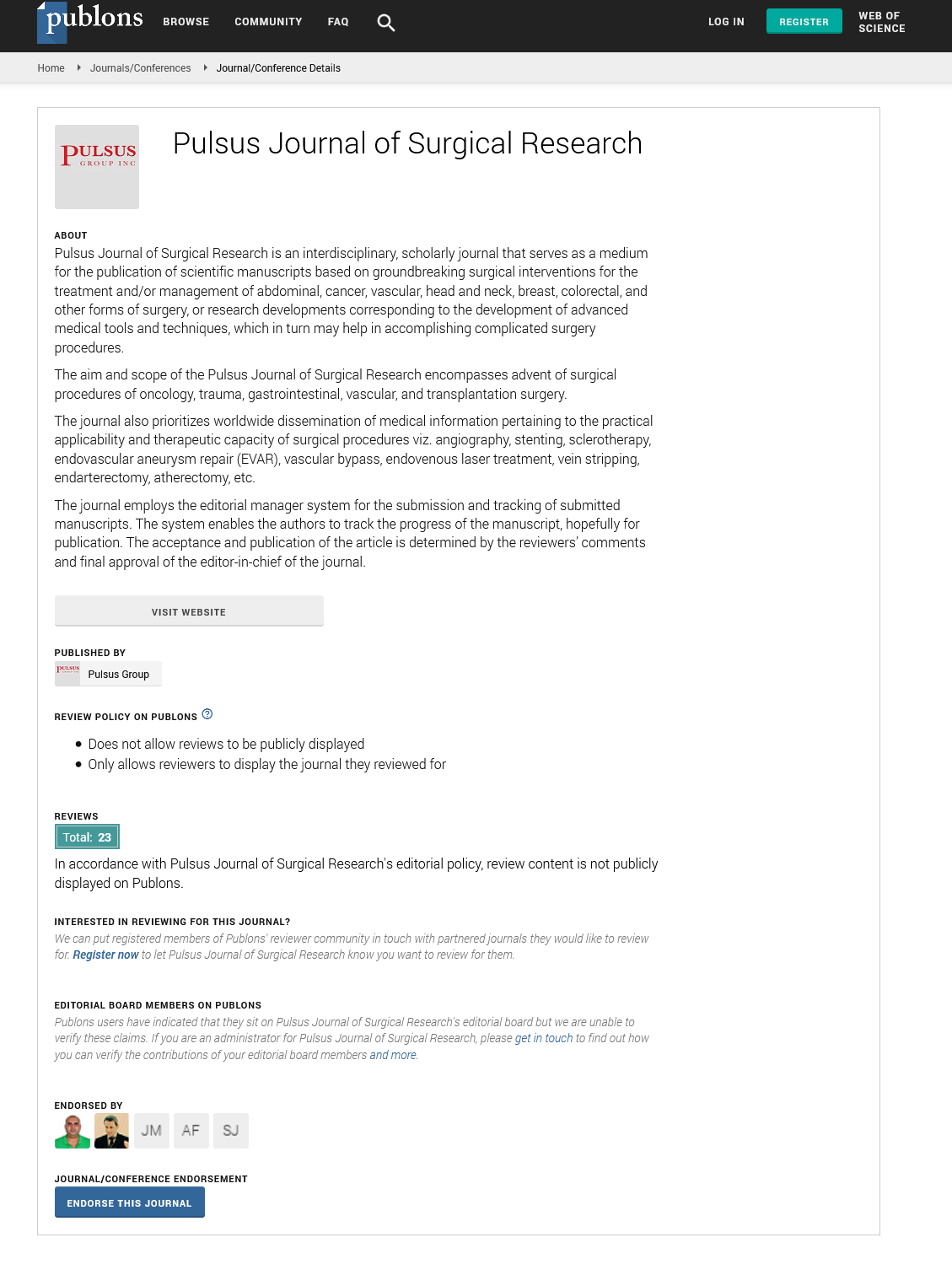A vestibular technique during trans-oral endoscopic endocrine surgery
Received: 03-Aug-2022, Manuscript No. pulpjsr- 22-5748; Editor assigned: 06-Aug-2022, Pre QC No. pulpjsr- 22-5748 (PQ); Accepted Date: Aug 26, 2022; Reviewed: 18-Aug-2022 QC No. pulpjsr- 22-5748 (Q); Revised: 24-Aug-2022, Manuscript No. pulpjsr- 22-5748 (R); Published: 30-Aug-2022
Citation: Mani S . a vestibular technique during trans-oral endoscopic endocrine surgery.J surg Res. 2022; 6(4):49-51.
This open-access article is distributed under the terms of the Creative Commons Attribution Non-Commercial License (CC BY-NC) (http://creativecommons.org/licenses/by-nc/4.0/), which permits reuse, distribution and reproduction of the article, provided that the original work is properly cited and the reuse is restricted to noncommercial purposes. For commercial reuse, contact reprints@pulsus.com
Abstract
The first five thyroid and parathyroid operations done using the Trans oral endoscopic vestibular technique. Retrospective data gathering for all endocrine procedures using the trans-oral endoscopic vestibular method We gathered and examined data on patient demographics, perioperative care, and complications. Using the trans-oral endoscopic vestibular technique, the desired specimen was successfully removed; conversion to the
conventional trans-cervical method was not necessary. The length of the hospital stay as well as the average operating time for the Para thyroidectomy instance were both very brief. One patient received a temporary mental nerve impairment, and another had a postoperative seroma that needed to be aspirated. In one instance, papillary thyroid cancer was found on histology, necessitating a full thyroidectomy.
Key Words
Surgical care; Virtual reality; Oral surgery; Anxiety
Introduction
The traditional trans-cervical technique in the late nineteenth century. Since that time, most surgeons perform thyroidectomies and Para thyroidectomies using the trans-cervical method as the norm. Some patients find the center visible neck scar caused by the trans-cervical technique to be unattractive from a cosmetic standpoint. Numerous alternative minimally invasive techniques have been published in the literature with the goal of a smaller scar on the neck or a scar less surgery in order to increase patient satisfaction and quality of life. These methods comprised a trans-axillary technique and a minimally invasive video-assisted thyroidectomy. The natural orifice transluminal endoscopic surgery was later made available for thyroid surgery. Initially, a sublingual or trans-tracheal method was used to get access. These procedures caused significant tissue damage and had high complication rates. Anuwong reported a method that allowed for scarless surgery, little tissue injury, and improved access to both lobes of the thyroid gland in order to enhance the cosmetic effects of thyroid surgery while retaining safety. Trans-oral endoscopic thyroidectomy vestibular approach is the name of this method. The trans-oral endoscopic thyroidectomy vestibular method uses incisions on the vestibular side of the lip and is completely scar less. Para thyroidectomies have been developed using a similar strategy. Tran’s oral partial Para thyroidectomy was the original name for this NOTES method procedure. The trans-oral endoscopic Para thyroidectomy vestibular technique was described by Sasanakietkul. It produced results that were comparable to those of the trans-oral endoscopic thyroidectomy vestibular technique.
As part of their preoperative work-up, patients had their vocal cords evaluated before surgery. The thyroid gland was examined using ultrasound technology. Using an ultrasound and a sestamibi parathyroid scan, the parathyroid adenoma was located prior to surgery. A radiologist conducted the ultrasound, and the operative surgeon confirmed the results. Prior to surgery, the patients were kept completely mouth-free. The surgical strategy chosen was based on the technique. The vestibular and gingival buccal folds each received three incisions. The initial cut was done in the middle of the oral vestibule on the lower lip. Between the canine and incisor, two lateral incisions were made. During the procedure, three Castro were used, and the room was produced by traversing the mandibular region and submental space to the anterior neck and lateral. Under close monitoring, the lateral 2 ports were implanted. Two 5 mm ports and one 10 mm port were used in each instance, with case number three being the sole exception. Three 5 mm ports were utilized in instance number three. The strap muscles were split and laterally retracted during dissection. The isthmus was located, broken down, and separated. Following that, the thyroid arteries were located, coagulated, and transected just outside the gland. The gland was then separated from the skull at the caudal lobe. Electromyography was used to monitor and preserve the Recurrent Laryngeal Nerve. The superior Laryngeal Nerve and the Vagus Nerve were not activated. It was possible to identify and preserve the parathyroid glands. The thyroid lobe was mobilized, the diseased gland was located and removed, and intraoperative parathyroid hormone sampling was used in the Para thyroidectomy instance. The central vestibular incision was used to access the specimen using an endo bag. The specimen was made easier to remove using a Hegar dilator. In every instance, no drains were needed. The absorbable suture was used to close the incisions. In case number one, the patient experienced postoperative seroma, necessitating two aspirations. The patient in case number two suffered a transient mental nerve lesion, which healed in six weeks. No postoperative infection, recurrent laryngeal nerve damage, hypoparathyroidism, hematoma formation, or bleeding was visible in any of the five instances. The thyroidectomy had to be finished via the trans-cervical technique after post-operative histology revealed papillary cancer. The TCA has become the industry standard of care for thyroid and parathyroid procedures. Some patients experienced an anterior neck scar that was unsightly and affected their quality of life. Minimally invasive surgical procedures have been available for two decades thanks to developments in the surgical sector. In the area of endocrine surgery, these advancements were modified. At first, remote access thyroid and parathyroid surgery, or the trans-axillary approach, was used; however, this technique was linked to a higher complication rate. The emergence of NOTES and the transoral technique were the results of further advancements in the surgical area. Outcomes that boost patient satisfaction and hence raise the quality of life. In numerous centers around the world, the same results have been repeated. The Trans oral strategy has many advantages. In the beginning, this method is thought of as a scarless procedure that gives the patient the desired cosmetic outcome and enhances their quality of life. Examined the difference in patient quality of life between patients who had a thyroidectomy using a trans-oral endoscopic method and those who used a trans-cervical incisional approach. The study's findings were statistically significant and showed that patients who underwent thyroidectomy via the Trans oral endoscopic method had improved quality of life, cosmetic results, and overall satisfaction. The Trans oral endoscopic method also clearly aided in the patient's quick recuperation and early return to work. Less post-operative pain was noted by patients who underwent TOETVA. This outcome has been repeated numerous times in other countries. Additionally, it is a minimally invasive treatment that allows for an adequate vision of the recurrent laryngeal nerve, examination of the parathyroid and thyroid glands, complete removal of a gland, and equivalent risks for complications to the traditional approach. There are some restrictions to the Trans oral endoscopic method of endocrine surgery. It offers a 2-dimensional field, particularly when using tools like a rigid endoscope. The potential challenges a surgeon can run into while extracting the material is another restriction of the process. The procedure's success depends on using the right patient selection criteria. Demonstrated that a Trans oral vestibular approach to the surgery was appropriate for more than half (55.8%) of patients who underwent thyroid or parathyroid surgery via the TCA. The three most frequent reasons for ineligibility for the transoral technique were non-localized hyperparathyroidism, prior neck surgery, and the need for neck dissection. Compared to the conventional TCA, the Trans oral endoscopic method to head and neck endocrine procedures takes longer to perform. Provided a thorough analysis of transoral thyroidectomies that showed the average operating duration. Operative time for case three of our series, the para- thyroidectomy. The operation time ranged, with an average of 151 minutes, for the remaining four instances, which required hemi thyroidectomies. This is comparable to other literary series. Due to intraoperative PTH sampling, which confirms the reduction in hormone levels before the surgery is finished, the Para thyroidectomy takes longer to perform. Prior to the procedure, informed consent should be acquired, and the advantages and risks of the surgery should be thoroughly discussed. Patients need to be aware of the possibility of switching to the more established TCA. Literature has demonstrated an appropriate conversion. Revealed a lower conversion rate. Additionally, if conversion is necessary, it is advised that the surgeon performing the treatment has sufficient TCA abilities and can successfully perform a central and modified neck dissection if needed. This surgeon should also perform more than 25 thyroidectomies annually. In our case series, conversion to open surgery was not necessary because all procedures were carried out using the trans-oral endoscopic vestibular technique. Due to access through the oral cavity, this method is categorized as a clean-contaminated wound. Transoral vestibular technique for thyroid and parathyroid surgery. Only one case of a neck infection was found after reviewing 686 cases. Our case study's findings didn't support wound infection. To protect against oral cavity microflora, all of our patients were given prophylactic antibiotics prior to surgery. Additionally, a 5-day course of post-operative antibiotics was given to all of our patients. The transoral endoscopic vestibular approach produced unique, novel complications as compared to the trans-cervical approach in terms of complications reported from the two techniques. Injury to the mental nerve, a branch of the inferior alveolar nerve that innervates the chin, gingivae, mucosa, and lower lip with sensory information, may happen. According to reports, there is a variable prevalence of mental nerve damage with the transoral vestibular approach. 1.5% of 200 individuals who received TOETVA in a series were found to have a mental nerve injury. In the majority of these cases, a temporary nerve injury that was fully recovered in less than six months was documented. One patient in our case series experienced temporary mental nerve palsy, which went away in six weeks. a new range of problems has been added as a result of the use of carbon dioxide during insufflation. The literature has described subcutaneous surgical emphysema, hypercarbia, and carbon dioxide embolism. Due to elevated intra-cavity pressure, the first two problems occurred. Therefore, utilizing a low pressure reduces the risk. Even though carbon dioxide embolism is a rare consequence, it can nonetheless happen. It has been documented in a case report that an anterior ugular vein laceration occurred during a robotic transoral thyroidectomy. RLN damage is a side effect of both endoscopic and traditional thyroidectomies. The frequency of both temporary and permanent RLN damage with trans-cervical approaches.
A thorough analysis of Tran’s oral thyroidectomies revealed that the incidence of both temporary and permanent RLN damage paralleled findings that examined the mechanism of RLN damage during TOETVA. The Trans oral endoscopic procedure is safe because these outcomes are comparable to those obtained using the traditional method. The trans-cervical and Trans oral vestibular methods had similar incidences of both temporary and permanent hypoparathyroidism. The first method documents an occurrence. It was mentioned in the Trans oral strategy.
There were more issues, according to reports in the literature. There have been case reports on flap perforation and burn caused by the diathermy device's transmitted heat. The traditional and Trans oral vestibular methods also carry the risk of hemorrhage, which is an additional consequence. The likelihood that hematomas will form during the Trans oral approach. A frequent complication of the Trans oral technique is postoperative seroma. One person in our study required two outpatient department-based aspirations due to a postoperative seroma that had developed.






